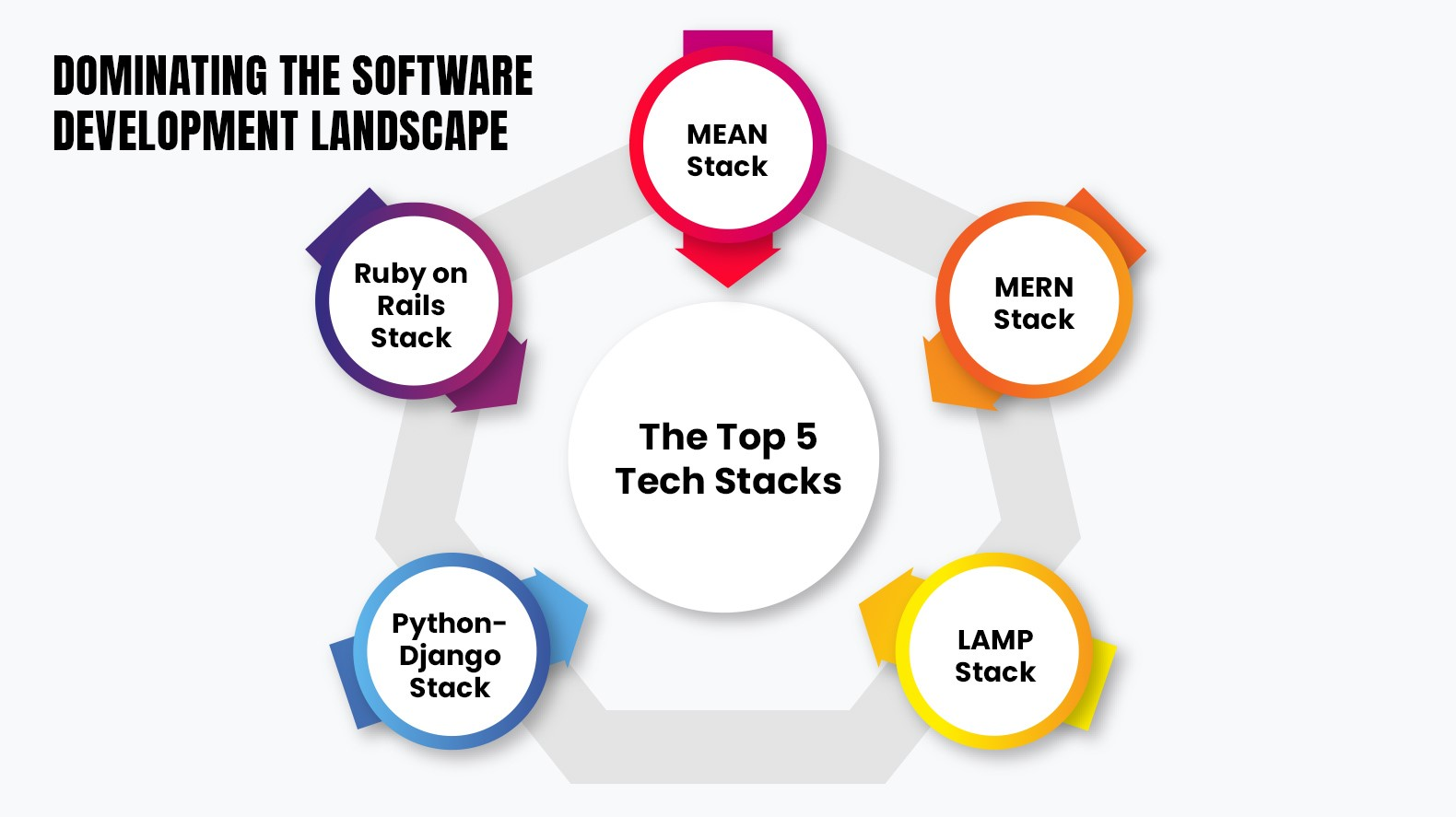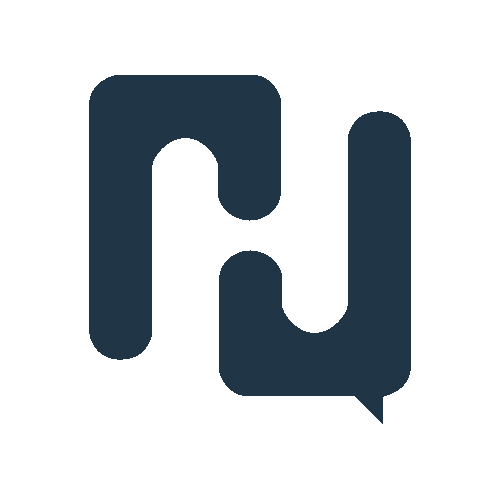Dominating the Software Development Landscape: Top 5 Tech Stacks

Software development is rapidly evolving, and selecting the right tech stack can lead to success. What is a tech stack? A software application comprises of a variety of programming languages, libraries, tools, and frameworks. With so many alternatives available, selecting the best tech stack may be challenging. This essay will assist you in comprehending each tech stack. Furthermore, it will help you discover the advantages of using tech stack in software development. It can help you choose the right stack.
-
MEAN Stack
A common choice for developing web apps is the MEAN stack. It consists of four essential parts: the NoSQL database MongoDB, the online application framework Express.js, the front-end JavaScript framework Angular, and the server-side JavaScript runtime Node.js. The MEAN stack is a flexible and effective choice for developers who are familiar with this language. The reason is that it is fully built on JavaScript. It is a potent tool for quick and scalable development because of its open-source software nature and broad community support.
Advantages Of Using The MEAN Tech Stack:
JavaScript Everywhere: MEAN enables programmers to utilize JavaScript as their primary programming language across an application's full lifecycle. This reduces context-switching for developers and makes it easier to find and hire developers who are proficient in JavaScript.
Real-Time Applications: MEAN's components, particularly Node.js, excel at handling real-time applications like chat systems, collaborative tools, or gaming platforms, where real-time data updates are crucial.
Scalability: The horizontal scalability of MongoDB, a NoSQL database, is possible through the dispersion of data over several servers. As a result, it is much simpler to manage massive volumes of data and user traffic.
Flexibility: Due to MongoDB's lack of a defined schema, developers are free to change the data structure. This makes it more adaptive to changing requirements during the development process.
Full-Stack Development: The MEAN stack provides a comprehensive solution for building both frontend and backend components. This makes it easier to manage and deploy the entire application.
-
MERN Stack
The MERN stack is another JavaScript-based technology stack that is similar to the MEAN stack. The front-end framework is where MERN differs the most from Angular, using React.js instead. React.js is popular for its flexibility and performance, making the MERN stack an excellent choice for building dynamic and interactive user interfaces. Like the MEAN stack, MERN relies on MongoDB, Express.js, and Node.js, providing developers with a full-stack solution for their web applications.
Advantages Of Using The MERN Tech Stack:
Full-stack JavaScript: MERN allows developers to use JavaScript throughout the entire application, both on the client and server sides. It also makes it simpler to share and reuse code, which lowers the need to transition between programming languages.
Rich Ecosystem: The MERN stack's individual components each have a sizable and vibrant community that provides a plethora of libraries, tools, and packages. This enables developers to find solutions to common problems quickly and efficiently.
Real-Time Applications: Due to its ability to provide bidirectional communication between the client and server utilizing technologies like WebSockets, MERN is well suited for developing real-time applications, such as chat apps or collaboration tools.
Scalability: The MERN stack can be easily scaled to handle high traffic and large datasets, especially with the use of MongoDB, which is popular for its horizontal scalability through sharding.
Isomorphic Applications: Using Node.js on the server-side allows for isomorphic applications, where the server and the client can share the same code, improving performance and reducing duplication.
-
LAMP Stack
The LAMP stack is a classic and time-tested choice for web development. Its four components are the operating system Linux, the web server Apache, the relational database management system MySQL, and the programming language PHP. Due to its stability, usability, and affordability, LAMP has been the preferred choice for many developers. It still has a high chance of winning, especially for initiatives that rely heavily on PHP-based content management systems like WordPress.
Advantages Of Using The LAMP Tech Stack:
Open-Source: All LAMP stack components are open-source, which means they are all available for free usage and have a strong developer community that works to enhance and secure them.
Platform Independence: LAMP is flexible and adaptable to diverse hosting settings since it is meant to be platform-independent, which allows it to be deployed on a variety of operating systems.
Reliability and Stability: The LAMP stack has been in use for a while and has shown to be robust and reliable for developing web applications.
Widespread Support From the Community: The popularity of LAMP has generated a sizable and active developer community, which has resulted in a wealth of online resources, tutorials, and discussion boards for troubleshooting and learning.
Scalability: The LAMP stack is suitable for both small- and large-scale applications because, with the right configuration and optimization, it can manage a sizable volume of users and traffic.
-
Python-Django Stack
When creating online apps, Python-Django is a strong mix that encourages clarity and clean code. Django is a high-level web framework that makes many web development tasks easier, freeing developers to concentrate on creating effective and enduring code. Developers love Python for its readability and flexibility, and when combined with Django, it makes a great choice for projects that need to be developed quickly without sacrificing quality.
Advantages Of Using Python-Django Stack:
Rapid Development: Rapid web application development is made simple by Django's high-level abstractions and built-in functionality. By adhering to the "don't repeat yourself" (DRY) philosophy, minimizes code duplication and boosts productivity.
Scalability: Django's architecture allows for scalability, making it suitable for small projects and large, high-traffic applications. It can handle heavy workloads with proper optimization and configuration.
Versatility: Django has a wide range of application possibilities, from basic websites to sophisticated, data-driven web apps. It supports a number of databases, enabling developers to select the one that best suits the requirements of their project.
Security: Django comes with a variety of built-in security measures to safeguard against common internet vulnerabilities like SQL injection, cross-site scripting (XSS), and cross-site request forgery (CSRF). By default, this aids developers in creating secure applications.
Community and Libraries: Python and Django have large and active communities that contribute to an extensive collection of third-party packages and libraries. This reduces the amount of time needed for development and enables developers to use existing solutions for varied jobs.
Django Admin Interface: A built-in admin interface is a powerful tool that enables developers to manage and interact with the application's data without having to build a custom admin system.
-
Ruby on Rails Stack
Built on the Ruby programming language, Ruby on Rails—often shortened to just Rails—is a powerful and approachable web application framework. The development process is streamlined, and developers may be quite efficient thanks to Rails, which prioritizes convention over configuration. Its elegant and expressive syntax makes it an enjoyable choice for developers who prioritize code readability and development speed. For new businesses and projects with a short deadline, Ruby on Rails is a fantastic choice.
Advantages of using Ruby on Rails:
Productivity: Convention over configuration is something that Ruby on Rails emphasizes. Because it adheres to standard practices, developers may concentrate on building business logic rather than boilerplate code. Faster development and higher production are the results.
Developer-Friendly: Ruby, the language on which Rails is based, is renowned for being straightforward and readable. Developers will find it more fun to work with because of its simple, elegant syntax.
Strong Community Support: There are several libraries and plugins available because of the large and active community that supports Ruby on Rails. They can expand the framework's functionality and address common development issues.
Rich Ecosystem: Due to the large number of tools and libraries that make up Ruby on Rails' ecosystem, integrating it with other technologies and services is made simpler. As a result, development moves more quickly and less needlessly.
Convention Over Configuration: Rails adheres to the tenet of "Convention over Configuration," which implies that it makes assumptions about how things ought to be done. It eliminates the need for manual setting and offers a constant framework for all projects.
Mature and Battle-Tested: Ruby on Rails has been around for many years and has been behind numerous successful projects. It has undergone extensive testing and improvement, making it a reliable and stable choice for web development.
How to Choose Tech Stack
When selecting the tech stack for your project, you should carefully take into account the following factors:
Project Requirements: Consider your project's specific requirements, including the type of application, target user base, and scalability requirements.
Team Expertise: Consider the expertise of your development team. Opt for a tech stack that aligns with their skills and experience.
Long-Term Vision: Consider the future and how the chosen tech stack will support the growth and maintenance of your application.
Market Trends: To make smart decisions, stay current with the newest trends and technology in the software development industry.
Conclusion
The correct tech stack may make all the difference in the changing world of software development. The MEAN, MERN, LAMP, Python-Django, and Ruby on Rails stacks are five excellent choices. Each with its unique strengths and capabilities. By choosing the right tech stack, you can confidently build robust and scalable applications that dominate the software development landscape.
